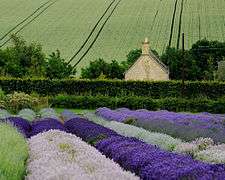Lavandula
| Lavender | |
|---|---|
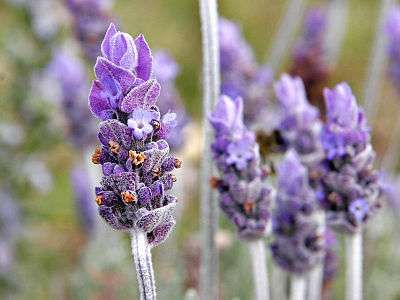 | |
| Lavender flowers with bracts | |
| Scientific classification | |
| Kingdom: | Plantae |
| (unranked): | Angiosperms |
| (unranked): | Eudicots |
| (unranked): | Asterids |
| Order: | Lamiales |
| Family: | Lamiaceae |
| Subfamily: | Nepetoideae |
| Tribe: | Lavanduleae |
| Genus: | Lavandula |
| Type species | |
| Lavandula spica L. | |
| Synonyms[1] | |
| |
Lavandula (common name lavender) is a genus of 39 known species of flowering plants in the mint family, Lamiaceae. It is native to the Old World and is found from Cape Verde and the Canary Islands, Europe across to northern and eastern Africa, the Mediterranean, southwest Asia to southeast India. Many members of the genus are cultivated extensively in temperate climates as ornamental plants for garden and landscape use, for use as culinary herbs, and also commercially for the extraction of essential oils. The most widely cultivated species, Lavandula angustifolia, is often referred to as lavender, and there is a color named for the shade of the flowers of this species.
Description
The genus includes annual or short-lived herbaceous perennial plants, and shrub-like perennials, subshrubs or small shrubs.[2]
Leaf shape is diverse across the genus. They are simple in some commonly cultivated species; in others they are pinnately toothed, or pinnate, sometimes multiple pinnate and dissected. In most species the leaves are covered in fine hairs or indumentum, which normally contain the essential oils.[2]
Flowers are borne in whorls, held on spikes rising above the foliage, the spikes being branched in some species. Some species produce coloured bracts at the apices. The flowers may be blue, violet or lilac in the wild species, occasionally blackish purple or yellowish. The calyx is tubular. The corolla is also tubular, usually with five lobes (the upper lip often cleft, and the lower lip has two clefts).[2][3]
Nomenclature and taxonomy
L. stoechas, L. pedunculata and L. dentata were known in Roman times.[4] From the Middle Ages onwards, the European species were considered two separate groups or genera, Stoechas (L. stoechas, L. pedunculata, L. dentata) and Lavandula (L. spica and L. latifolia), until Linnaeus combined them. He only recognised five species in Species Plantarum (1753), L. multifida and L. dentata (Spain) and L. stoechas and L. spica from Southern Europe. L. pedunculata was included within L. stoechas.
By 1790, L. pinnata and L. carnosa were recognised. The latter was subsequently transferred to Anisochilus. By 1826 Frédéric Charles Jean Gingins de la Sarraz listed 12 species in three sections, and by 1848 eighteen species were known.[4]
One of the first modern major classifications was that of Dorothy Chaytor in 1937 at Kew. The six sections she proposed for 28 species still left many intermediates that could not easily be assigned. Her sections included Stoechas, Spica, Subnudae, Pterostoechas, Chaetostachys and Dentatae. However all the major cultivated and commercial forms resided in the Stoechas and Spica sections. There were four species within Stoechas (Lavandula stoechas, L. dentata, L. viridis and L. pedunculata) while Spica had three (L. officinalis (now L. angustifolia), L. latifolia and L. lanata). She believed that the garden varieties were hybrids between true lavender L. angustifolia and spike lavender (L. latifolia). [5]
More recently, work has been done by Upson and Andrews, and currently Lavandula is considered to have three subgenera.
- Subgenus Lavandula is mainly of woody shrubs with entire leaves. It contains the principal species grown as ornamental plants and for oils. They are found across the Mediterranean region to northeast Africa and western Arabia.
- Subgenus Fabricia consists of shrubs and herbs, and it has a wide distribution from the Atlantic to India. It contains some ornamental plants.
- Subgenus Sabaudia constitutes two species in the southwest Arabian peninsula and Eritrea, which are rather distinct from the other species, and are sometimes placed in their own genus Sabaudia.
In addition, there are numerous hybrids and cultivars in commercial and horticultural usage.[2]
Etymology
The English word lavender is generally thought to be derived from Old French lavandre, ultimately from the Latin lavare (to wash), referring to the use of infusions of the plants.[6] The botanic name Lavandula as used by Linnaeus is considered to be derived from this and other European vernacular names for the plants. However it is suggested that this explanation may be apocryphal, and that the name may actually be derived from Latin livere, "blueish".[7]
The names widely used for some of the species, "English lavender", "French lavender" and "Spanish lavender" are all imprecisely applied. "English lavender" is commonly used for L. angustifolia, though some references say the proper term is "Old English Lavender".[8] The name "French lavender" may be used to refer to either L. stoechas or to L. dentata. "Spanish lavender" may be used to refer to L. stoechas, L. lanata or L. dentata.
Cultivation
The most common form in cultivation is the common or English lavender Lavandula angustifolia (formerly named L. officinalis). A wide range of cultivars can be found. Other commonly grown ornamental species are L. stoechas, L. dentata, and L. multifida (Egyptian lavender).
Because the cultivated forms are planted in gardens worldwide, they are occasionally found growing wild as garden escapes, well beyond their natural range. Commonly such adventitious establishment is apparently harmless at best, but in some cases Lavandula species have become invasive. For example, in Australia, Lavandula stoechas has become a cause for concern; it occurs widely throughout the continent, and has been declared a noxious weed in Victoria since 1920.[9] It also is regarded as a weed in parts of Spain.[10]
Lavenders flourish best in dry, well-drained, sandy or gravelly soils in full sun.[11] All types need little or no fertilizer and good air circulation. In areas of high humidity, root rot due to fungus infection can be a problem. Organic mulches can trap moisture around the plants' bases, encouraging root rot. Gravelly materials such as crushed rocks give better results.[12]
Lavender oil
Commercially, the plant is grown mainly for the production of essential oil of lavender. This has antiseptic[13][14] and anti-inflammatory[15] properties. These extracts are also used as fragrances for bath products.
English lavender (Lavandula angustifolia) yields an essential oil with sweet overtones, and can be used in balms, salves, perfumes, cosmetics, and topical applications. Lavandin, Lavandula × intermedia (also known as Dutch lavender), yields a similar essential oil, but with higher levels of terpenes including camphor, which add a sharper overtone to the fragrance.
The lavandins Lavandula × intermedia are a class of hybrids of L. angustifolia and L. latifolia.[16] The lavandins are widely cultivated for commercial use, since their flowers tend to be bigger than those of English lavender and the plants tend to be easier to harvest, but lavandin oil is regarded by some to be of a lower quality than that of English lavender, with a perfume less sweet.[17]
Culinary use
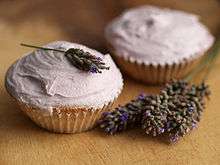
It is grown as a condiment and used in salads and dressings.[18] Flowers yield abundant nectar from which bees make a high-quality honey. Monofloral honey is produced primarily around the Mediterranean, and is marketed worldwide as a premium product. Flowers can be candied and are sometimes used as cake decorations. Lavender flavours baked goods and desserts (it pairs especially well with chocolate), and is also used to make "lavender sugar".[19] Lavender flowers are occasionally blended with black, green, or herbal teas.
Though it has many other traditional uses in southern France, lavender is not used in traditional southern French cooking. It does not appear at all in the best-known compendium of Provençal cooking, J.-B. Reboul's Cuisinière Provençale[20] In the 1970s, a blend of herbs called herbes de Provence which usually includes lavender was invented by spice wholesalers,[21] and lavender has more recently become popular in cooking.
Lavender lends a floral and slightly sweet flavour to most dishes, and is sometimes paired with sheep's-milk and goat's-milk cheeses. For most cooking applications the dried buds, which are also referred to as flowers, are used. Some chefs experiment with the leaves but only the buds contain the essential oil of lavender, from which the scent and flavour of lavender are derived. In the United States, both lavender syrup and dried lavender buds are used to make lavender scones and marshmallows.
Medical uses
The essential oil was used in hospitals during World War I.[11]
Lavender is used extensively with herbs such as chamomile in aromatherapy.
A study published in 2010 investigated anxiolytic effects and influence on sleep quality. Lavender oil with a high percentage of linalool and linalyl acetate, in the form of capsules, was generally well tolerated. It showed meaningful efficacy in alleviating anxiety and related sleep disturbances.[22][23]
Lavender oil is approved for use as an anxiolytic in Germany under the name Lasea.[24][25] A survey paper on lavender and the nervous system published in 2013 states that, "there is growing evidence suggesting that lavender oil may be an effective medicament in treatment of several neurological disorders."[23]
Lavender honey (created from bees feeding on lavender plants), instead of lavender essential oil has the best effects of uninfected wounds.[26]
Health precautions
The U.S. National Institutes of Health (NIH) states that lavender is considered likely safe in food amounts and possibly safe in medicinal amounts. NIH does not recommend the use of lavender while pregnant or breast-feeding because of lack of knowledge of its effects. It recommends caution if young boys use lavender oil because of possible hormonal effects leading to gynecomastia, and states that lavender can cause skin irritation.[27][28]
Gynecomastia
A study was published in 2007 on the use of lavender and gynecomastia in prepubescent boys.[29] Three young boys developed gynecomastia while using products containing lavender.[30] The boys stopped using the products, and the gynecomastia abated. The researchers found that lavender and tea tree oil can cause estrogenic and antiandrogenic activities in cell cultures, and the paper states that "repeated topical exposure to lavender and tea tree oils probably caused prepubertal gynecomastia in these boys." After the study was published The New England Journal of Medicine received letters disputing the paper's findings, and the authors were allowed to respond.[31]
The Aromatherapy Trade Council of the UK and the Australian Tea Tree Association have published rebuttals.[32][33]
The Aromatherapy Trade Council's rebuttal states among other things that:
- It isn't likely that there would be sufficient lavender in the personal care products used in the three cases to cause an endocrine effect.
- The gyncomastia might have come from another source. The rebuttal states that endocrine disruptors such as medications, oral contraceptives, marijuana and soy products were considered; however, other disruptors such as organochloride pesticides, PCBs, polychlorinated dioxins, alkyl phenols, phthalates, and parabens were not. The paper states that it is not clear that the lavender and/or tea tree oil caused the gynecomastia but say that, "other components in these products may also possess endocrine-disrupting activity that contributed to the gynecomastia, but those components were not tested because we chose to evaluate only the component that was found in all the products used by the patients (lavender oil) and a chemically similar component that was found in some of the products (tea tree oil)."[30]
- The rebuttal points out that lavender is in widespread use saying, "considering that some 200 tonnes per annum are produced of both lavender and tea tree oil, that most of this goes into personal care products, and that very little of the evidence presented for these 3 cases is convincing, the press reports of caution are premature."
The Australian Tea Tree Industry Association rebuttal states that various other plants have estrogen inducing effects in essential oil form, including, "soy, hops, garbanzo beans, red clover, lentils, flaxseed, sunflower seeds, alfalfa sprouts, liquorice, and ginseng."[33]
A study published in 2010 from the Research Institute for Fragrance Materials did not find estrogenic activity from lavender oil in laboratory animals.[34] A newer version of the paper became available in 2013.
Skin irritant
In 2004, a study was published which found that, "lavender oil is cytotoxic to human skin cells in vitro".[35] On the other hand, aromatherapist Robert Tisserand points out in a blog post that: "Any type of in vitro test is only suggestive of a possible effect. You can never assume that the same effect will take place in the living body."[36]
A review published in 2005 on lavender essential oil states that, "Lavender is traditionally regarded as a 'safe' oil and, although it was recently reported that lavender oil, and its major constituent linalyl acetate, are toxic to human skin cells in vitro, contact dermatitis to lavender oil appears to occur at only a very low frequency."[37]
Photo sensitivity
A study was published in 2007 which looked at the relationship between various fragrances and photosensitivity. The study stated that lavender is known "to elicit cutaneous photo-toxic reactions". However, the research did not find that lavender induced photohaemolysis.[38]
Other uses
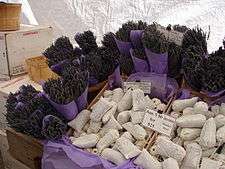
Flower spikes are used for dried flower arrangements. The fragrant, pale purple flowers and flower buds are used in potpourris. Lavender is also used extensively as herbal filler inside sachets used to freshen linens. Dried and sealed in pouches, lavender flowers are placed among stored items of clothing to give a fresh fragrance and to deter moths. Dried lavender flowers have become recently popular for wedding confetti. Lavender is also popular in scented waters and sachets.
In history and culture
The ancient Greeks called the lavender herb nardus, after the Syrian city of Naarda (possibly the modern town of Dohuk, Iraq). It was also commonly called nard.[39] The species originally grown was L. stoechas.[2]
Lavender was one of the holy herbs used in the biblical Temple to prepare the holy essence, and nard ('nerd' in Hebrew) is mentioned in the Song of Solomon (4,14)
nard and saffron,[40]
calamus and cinnamon,
with every kind of incense tree,
with myrrh and aloes,
and all the finest spices.[41]
During Roman times, flowers were sold for 100 denarii per pound, which was about the same as a month's wages for a farm laborer, or fifty haircuts from the local barber. Its late Latin name was lavandārius, from lavanda (things to be washed), from the verb lavāre (to wash).[42]
Taxonomic table
This is based on the classification of Upson and Andrews, 2004.
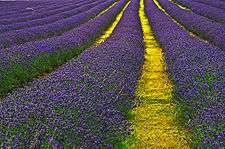
|
I. Subgenus lavendula" Upson & S.Andrews subgen. nov.
II. Subgenus Fabricia (Adams.) Upson & S. Andrews, comb.nov.
III. Subgenus Sabaudia (Buscal. & Muschl.) Upson & S. Andrews, comb. et stat. nov.
|
Gallery
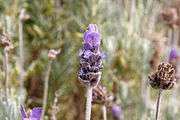 Lavender flower
Lavender flower Flower of cultivated lavender; Lavandula stoechas
Flower of cultivated lavender; Lavandula stoechas Lavender garden, India
Lavender garden, India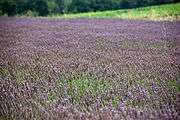 A field of lavender in France
A field of lavender in France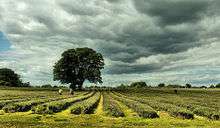 A field of lavender on the edge of the London Borough of Sutton, England
A field of lavender on the edge of the London Borough of Sutton, England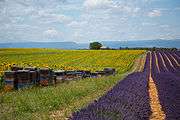 Lavender and honeybees outside Aix-en-Provence, France
Lavender and honeybees outside Aix-en-Provence, France
Notes
- ↑ "World Checklist of Selected Plant Families: Royal Botanic Gardens, Kew". kew.org.
- 1 2 3 4 5 Upson T, Andrews S (2004). The Genus Lavandula. Royal Botanic Gardens, Kew 2004. ISBN 9780881926422. Retrieved 2012-03-30.
- ↑ L. H. Bailey. Manual of Cultivated Plants. MacMillan Publishing Company.
- 1 2 Lis-Balchin M, ed. (2002). Lavender: The genus Lavandula. Taylor and Francis. ISBN 9780203216521.
- ↑ Chaytor D A. A taxonomic study of the genus Lavandula. 1937
- ↑ Concise Oxford Dictionary
- ↑ The alternative derivation of the name lavender from Latin livere and medieval Latin lavindula is given in Upson and Andrews, where it is presented as a conjecture. The problems with the standard derivation are also described; such as that there is no knowledge of the common use of lavender for washing by Greeks and Romans.
- ↑ Hillier
- ↑ Carr, G.W, Yugovic, J.V and Robinson, K.E.. 'Environmental Weed Invasions in Victoria – conservation and management implications' 1992 Pub: Department of Conservation and Environment and Ecological Horticulture, Victoria, Australia
- ↑ Csurches S., Edwards R.; National Weeds Program, Potential Environmental Weeds in Australia, Candidate Species for Preventative Control; Queensland Department of Natural Resources. January 1998 ISBN 0-642-21409-3 Also
- 1 2 Grieve, Mrs. M. A Modern Herbal, Vol. II, New York: Dover Publications, Inc., 1971. ISBN 0-486-22799-5)
- ↑ Kathleen Norris Brenzel, editor, The Sunset Western Garden Book, 7th Edition
- ↑ Moon, T; Wilkinson, JM; Cavanagh, HM (2006). "Antiparasitic activity of two Lavandula essential oils against Giardia duodenalis, Trichomonas vaginalis and Hexamita inflata". Parasitology research. 99 (6): 722–8. doi:10.1007/s00436-006-0234-8. PMID 16741725.
- ↑ Inouye, S.; Takizawa, T.; Yamaguchi, H. (2001). "Antibacterial activity of essential oils and their major constituents against respiratory tract pathogens by gaseous contact". Journal of Antimicrobial Chemotherapy. 47 (5): 565–73. doi:10.1093/jac/47.5.565. PMID 11328766.
- ↑ Hajhashemi, V; Ghannadi, A; Sharif, B (2003). "Anti-inflammatory and analgesic properties of the leaf extracts and essential oil of Lavandula angustifolia Mill". Journal of Ethnopharmacology. 89 (1): 67–71. doi:10.1016/S0378-8741(03)00234-4. PMID 14522434.
- ↑ Mark Griffiths, Index of Garden Plants (Portland, Oregon: Timber Press, 1994. ISBN 0-333-59149-6.)
- ↑ National Non-Food Crops Centre. "Lavender". Retrieved on 2009-04-23.
- ↑ M. G. Kains (1912). American Agriculturist, ed. Culinary Herbs: Their Cultivation Harvesting Curing and Uses (English). Orange Judd Company.
- ↑ "Cooking with Lavender - Purple Haze Lavender (Sequim, WA)". Purple Haze Lavender.
- ↑ J.-B. Reboul; Cuisinière Provençale (1910)
- ↑ Laget, F. (2005). "From its Birthplace in Egypt to Marseilles, an Ancient Trade: Drugs and Spices". Diogenes. 52 (3): 131–139. doi:10.1177/0392192105055941.
- ↑ Kasper, S; Gastpar, M; Müller, WE; Volz, HP; Möller, HJ; Dienel, A; Schläfke, S (2010). "Silexan, an orally administered Lavandula oil preparation, is effective in the treatment of 'subsyndromal' anxiety disorder: a randomized, double-blind, placebo controlled trial". International clinical psychopharmacology. 25 (5): 277–87. doi:10.1097/YIC.0b013e32833b3242. PMID 20512042.
- 1 2 Koulivand, PH; Khaleghi, Ghadiri M; Gorji, A (2013). "Lavender and the nervous system". Evidence-Based Complementary and Alternative Medicine. 2013: 681304. doi:10.1155/2013/681304. PMID 23573142.
- ↑ "LASEA – SILEXAN – Lavender Oil Pills For Anxiety". Retrieved 2013-11-06.
- ↑ Tisserand, Robert (11 November 2010). "No suspension of disbelief required « Robert Tisserand". Retrieved 2013-11-06.
- ↑ Catriona Jones (November 2011). "The efficacy of lavender oil on perineal trauma: A review of the evidence___". Complementary Therapies in Clinical Practice. 17 (4): 215–220. doi:10.1016/j.ctcp.2011.01.003.
- ↑ "Lavender: MedlinePlus Supplements". National Institutes of Health. 9 November 2012. Retrieved 2013-11-05.
- ↑ "Lavender: Science and Safety". National Center for Complementary and Integrative Health. March 2007. Retrieved 2013-11-05.
- ↑ Miranda Hitti; Reviewer Louise Chang MD (31 January 2007). "Lavender Oil May Spur Breasts in Boys". WebMD, LLC. Retrieved 2013-11-06.
- 1 2 Henley, Derek V.; Lipson, Natasha; Korach, Kenneth S.; Bloch, Clifford A. (2007). "Prepubertal Gynecomastia Linked to Lavender and Tea Tree Oils". New England Journal of Medicine. 356 (5): 479 85. doi:10.1056/NEJMoa064725. PMID 17267908.
- ↑ "Prepubertal Gynecomastia Linked to Lavender and Tea Tree Oils|Letters". The New England Journal of Medicine,. 14 June 2007. Retrieved 2013-11-05.
- ↑ "Neither Lavender Oil Nor Tea Tree Oil Can Be Linked To Breast Growth in Young Boys". Aromatherapy Trade Council. 3 April 2007. Retrieved 2013-11-06.
- 1 2 "ATTIA refutes gynecomastia link". Australian Tea Tree Industry Association. 21 February 2007. Retrieved 2013-11-05.
- ↑ Politano, V.T.; McGinty, D.; Lewis, E.M.; Hoberman, A.M.; Christian, M.S.; Diener, R.M.; Api, A.M. (Mar–Apr 2013). "Uterotrophic assay of percutaneous lavender oil in immature female rats". International journal of toxicology. 32 (2): 123–9. doi:10.1177/1091581812472209. PMID 23358464.
- ↑ Prashar, A.; Locke, IC.; Evans, CS. (Jun 2004). "Cytotoxicity of lavender oil and its major components to human skin cells.". Cell Prolif. 37 (3): 221–9. doi:10.1111/j.1365-2184.2004.00307.x. PMID 15144499.
- ↑ Tisserand, Robert (25 August 2011). "Lavender oil – skin savior or skin irritant? « Robert Tisserand". Retrieved 2013-11-06.
- ↑ Cavanagh, Heather MA; Wilkinson, Jenny M (March 2005). "Lavender essential oil: a review" (PDF). Australian Infection Control. CSIRO Publishing. Retrieved 2013-11-06.
- ↑ Placzek, M; Frömel, W; Eberlein, B; Gilbertz, KP; Przybilla, B (2007). "Evaluation of phototoxic properties of fragrances.". Acta dermato-venereologica. 87 (4): 312–6. doi:10.2340/00015555-0251. PMID 17598033.
Also, oils of lemon, lavender, lime, sandalwood and cedar are known to elicit cutaneous phototoxic reactions, but lavender, sandalwood and cedar oil did not induce photohaemolysis in our assay...Lavender oil and sandalwood oil did not induce photohaemolysis in our test system. However, a few reports on photosensitivity reactions due to these substances have been published, e.g. one patient with persistent light reaction and a positive photo-patch test to sandalwood oil
- ↑ The origin of most of these quotes comes from Dr. William Thomas Fernie, in his book "Herbal Simples" (Bristol Pub., 1895. ASIN: B0014W4WNE). A digital copy of the book can be read online via google books. 'By the Greeks the name Nardus is given to Lavender, from Naarda, a city of Syria near the Euphrates, and many persons call the plant "Nard." St. Mark mentions this as Spikenard, a thing of great value. In Pliny's time, blossoms of the Nardus sold for a hundred Roman denarii (or L.3 2s. 6d.) the pound. This Lavender or Nardus was called Asarum by the Romans, because it was not used in garlands or chaplets. It was formerly believed that the asp, a dangerous kind of viper, made Lavender its habitual place of abode, so that the plant had to be approached with great caution.'
- ↑ "Song of Solomon". Bible Gateway.
- ↑ The assumption of the history of Lavender, originating from Naarda, along with the facts about the price in Roman time, are quoted widely throuout the web (over 350 entries in a google search) calling the city Naarda, Nerdus or Nardus. The Bible has many mentions of a fragrant plant called "Nerd" and the Mishna recited daily in Jewish prayers, refers to "Shibolet Nerd" (Hebrew for "Nard Spike") as one of the herbs used for making the holy essence at the biblical Temple. Dr. Fernie is the first known to link "Nard" with the city of Nerdus – Naarda, one of the major cities of Jewish study and origin of the Talmud, during the years A.D. 150–1100. Since Naarda or Neharde'a – river of 'A – was on a canal between the Euphrates and Tigris rivers, it could never have been a Syrian city, but rather in present day Iraq, somewhere in the Baghdad area. Dr Fernie refers widely to Jewish studies, probably quoted from a former botanist Robert Turner.
- ↑ Oxford English Dictionary (second ed.). 1989.
Note however that Upson and Andrews refer to research on bathing in the Roman Empire, and state that there is no mention of the use of lavender in works on this subject.
References
- Chaytor D A. A taxonomic study of the genus Lavandula. 1937
- Upson T, Andrews S. The Genus Lavandula. Royal Botanic Gardens, Kew 2004
- United States Department of Agriculture GRIN: Lavandula
External links
- Lavandula at DMOZ
- Medicinal use from University of Maryland Medical Center
